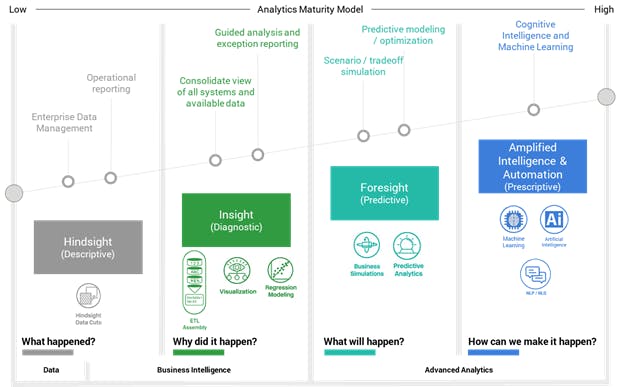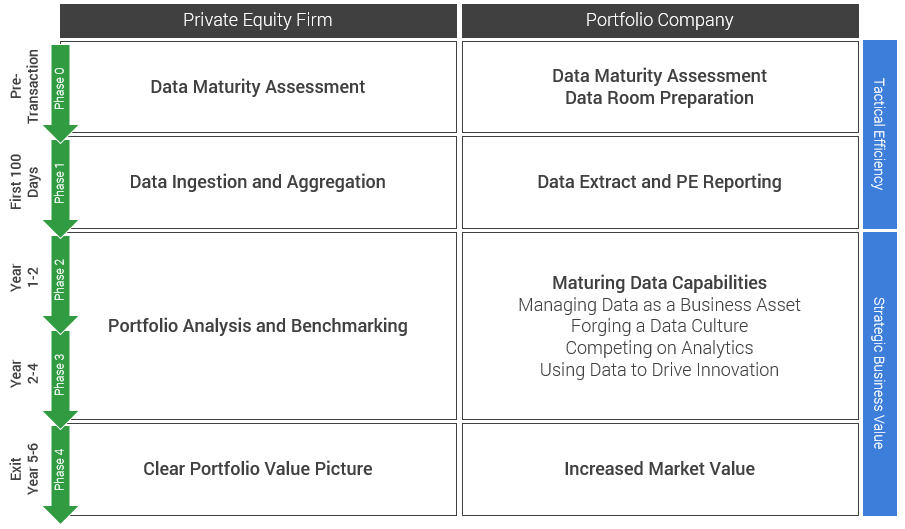
Private equity firms win when they help portfolio companies with their data maturity journey
Data maturity and organizational transformation go hand in hand; an organization that gets better at harnessing its data will see transformation in its people, processes and overall business results. Data analytics maturity happens when an organization improves how they leverage their most important data to make critical business decisions.
As private equity (PE) firms scout the landscape for appropriate portfolio acquisitions, we have seen an increased focus on firms looking for target companies that can not only speak about, but demonstrate, data maturity. This includes having the organizational culture that will support the transformational work necessary to move up the data analytics maturity model (shown below). Advanced data analytics can support both PE investors and portfolio companies through every stage of a transaction life cycle.
Data maturity – which can look different across domains like sales, finance and human resources – is a shift from a backward looking, tactical approach regarding data to a forward-looking strategic approach.
All organizations start with a view of their data that shows “what happened.” Descriptive analytics is a fundamental component of any business, but has limited effectiveness in today’s quickly changing world.
Example: In the early stages of data maturity, an organization is looking to pull financial statements and close the books in a timely manner. This gives a view into what occurred in a month but can be difficult to act on as the events have already occurred.
Once an organization knows what happened, they need to move deeper into diagnostic analytics, to understand “why did something happen?” The analysis at this phase must provide a level of detail that allows the end user to draw connections to events and present that information quickly enough to make actionable decisions.
Example: Using data from monthly financial statements, determine why revenue trended down or up, broken out by geography or product line. From here, action can be taken to address issues in a specific area of the business.
Organizations then advance into predictive analytics, understanding “what will happen?” This phase features the use of advanced analytical technologies to both predict and group given outcomes, leveraging both historical data sets as well as current information.
Example: Based on historical data from financials and other sources, forecast sales trends. Accurately forecasting gives organizations the foresight to pivot away from negative events or take advantage of opportunities.
The final phase in the maturity model is prescriptive analytics, automated decision making using sophisticated algorithms applied to a massive volume of data that is impossible for a human being to analyze. Google Maps employs this type of intelligence when giving driving directions. If enough slowdowns exist in an area, Google Maps will automatically reroute drivers to an alternate route.
Example: Creating an algorithm that monitors sales in a geographical area, and if sales are up and supply is tight, automatically raises prices without human intervention.

When a PE firm consider a portfolio company’s data, it looks at the organization holistically, in an effort to create a “single source of truth” for data relating to people, process and technology, so that everyone in the company is making decisions based on the same data. From that solid base, a business can use its data in ways that helps it run more efficiently but also adds some incremental revenue.

In the PE space, data analytics maturity is a move from a tactical play to a more strategic play that ultimately helps a company differentiate from its competitors. The tactical element includes identifying possible investments and the related due diligence regarding data maturity. The strategic element, which occurs post-close, includes benchmarking data capabilities, managing data as a business asset, and ultimately creating a clear portfolio value picture as the PE firm approaches exit of that investment.
Theoretically, a company becomes more valuable as its data maturity increases.
The gold star of data maturity is monetization. Facebook and Google earn most of their revenue by monetizing the data of their users. The Kroger grocery store chain is monetizing data by collecting point of sale data from customers, anonymizing it and then selling it to packaged goods manufacturers.
PE firms may work with outside advisors to help improve the data maturity of their portfolio companies. The process may start with a two- to eight-week data and analytics assessment of the company. The assessment will surface the company’s key business objectives and the data that supports those objectives. Next, the PE firm must determine if the organization has the mechanisms to fulfill those objectives. These mechanisms are not just technology but include having the right people in the right roles and employing the right business processes. Finally, the company determines if the current organizational culture will support what is needed to meet the objectives.
The next step is creating a two- to three-year road map that organizations can follow to increase their data maturity. While the organization has to do the hard work of creating operational efficiencies and bringing on the right staff, they can work with outside advisors, making sure that they are staying on track. A company can also outsource to a managed services company any of the analytical pieces that are part of the road map to maturity.
Organizations of any size can benefit from the incremental nature of data maturity. Maybe all an organization wants is a dashboard that will provide them a better view on existing sales data. Maybe a PE firm needs help in how to standardize how they collect financial information from their portfolio companies. At the opposite end of the maturity spectrum, organizations may need assistance in building a robust infrastructure team and the related processes. The process can take several years but can be scaled up or down depending on the needs of the organization.
PE investors generally have an idea of how long they want to hold on to an investment. PE firms naturally want to create and enhance the value of their portfolio companies. The data maturity journey is unique to each engagement and is designed ultimately to increase the portfolio company’s value, including better operating efficiency and incremental revenue from new products and service offerings.
Baker Tilly can help the portfolio company stand up the strategy and then execute the strategy using the core infrastructure already in place, and, if needed run the strategy under a managed service kind of engagement.
So when building your investment strategy, understanding your key data is important. Baker Tilly has deep technical experience to drive the right data analytics solutions from data collection to data visualization to advanced predictive analytics. Our data value proposition is combining industry experience with technical experience to create high quality high value solutions for our clients.
For more information on this topic, or to learn how Baker Tilly’s private equity industry specialists can help, contact our team.
